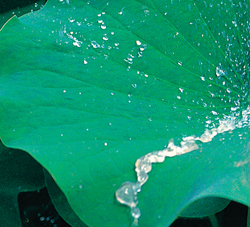The Ultimate Flattery
Learning from Nature through Biomimicry
It used to be that the house of the future was thought to involve robots, and lots of them, doing all the tedious work, Jetsons-style. They would clean the kitchen, prune the bushes and wash the laundry, all without complaint, while we humans would relax in the lap of luxury.
Like George Jetson’s three-hour workday, the "bots that would do this dirty work for us have not yet appeared. But maybe we don’t need clanking metal slaves; the emerging field of biomimicry is more eco-friendly—and smarter—than an army of tin machines.

Biomimicry is the concept that we can look at natural systems to solve such problems as keeping cool in the heat, recycling toxic wastes or self cleaning. This new science doesn’t involve taking any part from an existing animal or plant, but instead mimicking the means by which the problem has been solved over millennia. Unlike typical human solutions to natural problems, which often involve the use of large quantities of energy or toxic chemicals, "biomimetics" are products or processes that copy natural designs, which by nature are usually non-polluting and use minimal energy.
Janine Benyus, author of the leading tome Biomimicry (1997) and co-founder of the Biomimicry Guild, which brings biologists and designers from major companies together, says, "Biomimetics have entered categories of products from cleaning, lighting, building, adhesives, health care, clothing, water harvesting, furniture and waste management." For the average homeowner, that means that smart products based on natural systems are available today, and more are expected in the near future.

Clean Freaks, Rejoice!
One of the latest biomimetics to be offered in the U.S. is Lotusan from Georgia-based Sto Corporation. Bryce Brandon, the product’s market manager, explains that Lotusan is a special kind of paint that is based on the lotus leaf, which stays clean even in the dirtiest water. "In Germany, our parent company [Sto AG] developed this paint that, when dry, forms the same micro-textured surface as that found on lotus leaves," says Brandon.
Instead of a flat surface (which one might assume would be easiest to clean), Lotusan creates a microscopic matrix of hills and valleys. "This allows dirt to be picked up by the water molecules that travel across them," explains Brandon. So far, Lotusan has been used mostly on commercial buildings, which require no power washing with toxic cleaners to keep looking as fresh and shiny as a lotus leaf. "We are making plans to enter the residential market, and the paint has already been used on a few houses," adds Brandon.
As the Keep Antibiotics Working Campaign warns, soaps that kill bacteria are known to cause antibiotic resistance, giving rise to "superbugs" that may be particularly worrisome in hospital settings. So a new way to keep clean was needed. Taking the cue from a certain type of non-slimy algae (it’s bacteria that cause algae slime or "bio-film"), Biosignal was developed in Australia. This "sidesteps the issue of bacterial resistance," explains the company website. Biosignal is working on antibacterial paints, as well as other applications from contact lenses to cosmetics.
Colors and Clean Air
Keeping toxins out of our indoor air is a concern for anyone involved in green building. Columbia Forest Products makes a plywood held together with a resin that the company says is completely nontoxic. Unlike typical formaldehyde-based resins, which have been found to off-gas this suspected carcinogen into homes, the company’s PureBond mimics the way bivalve shellfish attach to stationary surfaces in the ocean. Waterproof PureBond is currently available in several nontoxic colors and is ideal for any project in which plywood would be used, from kitchen cabinets to shelving.
"Structural color paints and draperies are up-and-coming alternatives to traditional textiles and paints," says Benyus. Dyeing fabric typically causes significant water pollution, and since most dyeing is done in developing countries, it can sicken local communities and use large quantities of water.
"Hummingbirds, peacocks and butterflies don’t have pigment to create their colors," says Benyus. "Structural color is based on the way these animals create color, which is by using underlying structures that reflect light in a certain way. It only appears as if certain colors exist, when actually it’s just the eye’s perception of color," she explains. San Francisco-based Deepa Textiles makes beautiful, iridescent drapery called Natural Intelligence that’s based on mimicry of the Morpho butterfly.
Other nature-inspired home solutions include windows that adjust their shading automatically to keep a home or office cool or warm (inspired by cuttlefish), packaging that can be both flexible and hard (based on sea cucumbers), and a product that prevents mineral build-up in the pipes of your home, using what we know about seashells.
STARRE VARTAN believes human beings have much to learn from the natural world.

